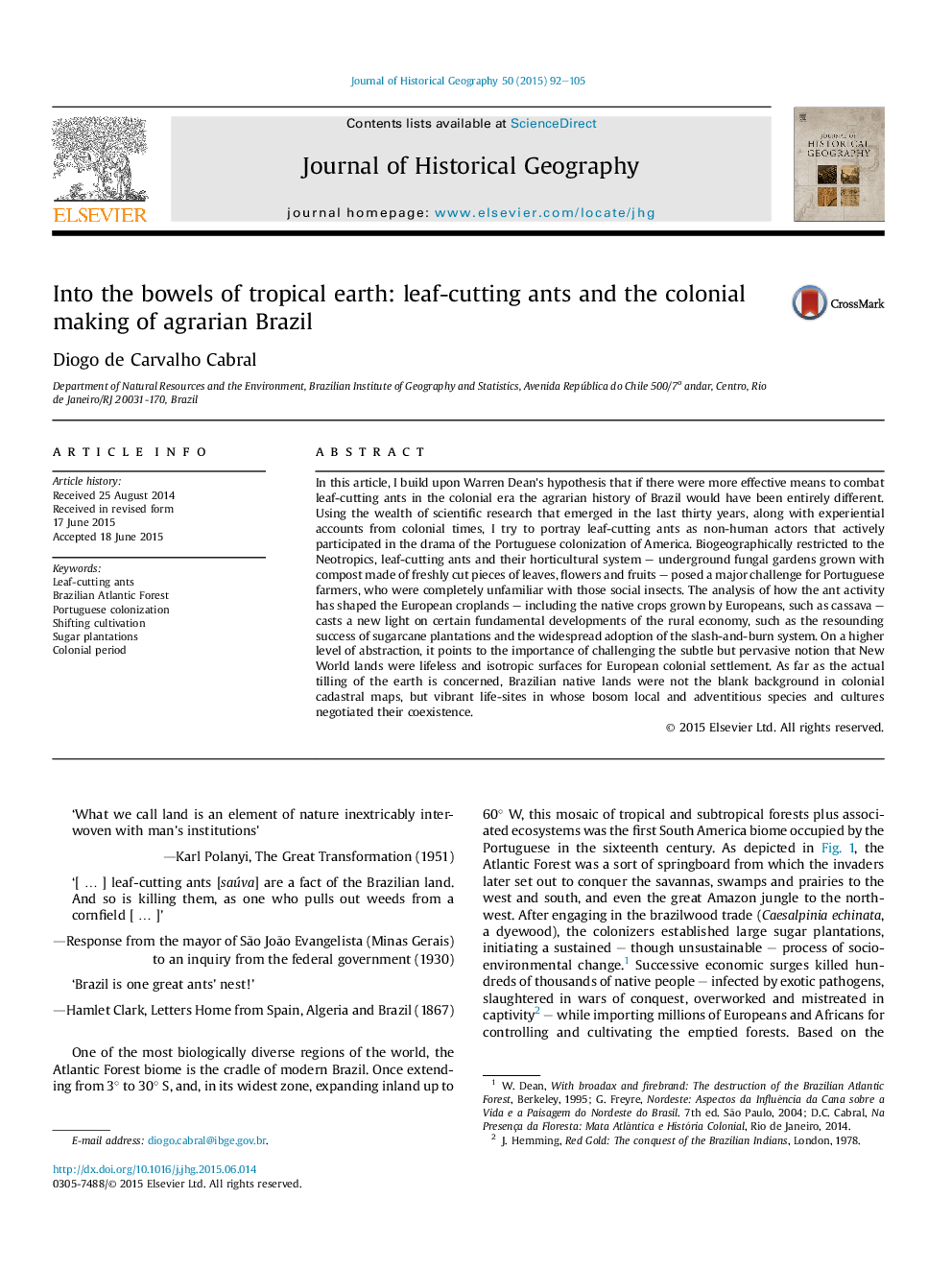| کد مقاله | کد نشریه | سال انتشار | مقاله انگلیسی | نسخه تمام متن |
|---|---|---|---|---|
| 7447542 | 1483975 | 2015 | 14 صفحه PDF | دانلود رایگان |
عنوان انگلیسی مقاله ISI
Into the bowels of tropical earth: leaf-cutting ants and the colonial making of agrarian Brazil
ترجمه فارسی عنوان
به روده های زمین گرمسیری: مورچه های برش برگ و ساخت استعمار برزیل کشاورزی
دانلود مقاله + سفارش ترجمه
دانلود مقاله ISI انگلیسی
رایگان برای ایرانیان
کلمات کلیدی
ترجمه چکیده
در این مقاله، بر فرض فرض وارن دین تأکید می کنم که اگر ابزار مؤثرتری برای مقابله با مورچه ها در دوران استعمار بر روی مورچه های بریده شده وجود داشته باشد، تاریخ زراعی برزیل کاملا متفاوت بود. با استفاده از ثروت تحقیقات علمی که در سی سال گذشته به وجود آمد، همراه با گزارش های تجربی از زمان استعمار، من سعی می کنم که مورچه های بریدن برگ را به عنوان بازیگران غیر انسانی معرفی کنم که به طور فعال در نمایش استعمار پرتغال پرتغال آمریکا شرکت داشتند. گیاه شناسی محدود به نئوتروپیک ها، مورچه های برش برگ و سیستم باغبانی آنها - باغ های قارچی زیرزمینی با کمپوست که از برگ های تازه برگ، گل و میوه تهیه شده اند، یک معضل بزرگ برای کشاورزان پرتغالی بود که کاملا با آن حشرات اجتماعی آشنا نبودند. تجزیه و تحلیل این که چگونه فعالیت مورچه اراضی اروپایی شکل گرفته است - از جمله محصولات زراعی بومی اروپایی ها، از قبیل کارسووا، نور جدیدی را در مورد تحولات بنیادینی از اقتصاد روستایی، از قبیل موفقیت فراوان نرده های نیشکر و پذیرش گسترده از سیستم بریدگی و سوختگی. در سطح بالاتری از انتزاع، آن را به اهمیت به چالش کشیدن مفهوم ظریف اما فراگیر اشاره می کند که زمین های جدید جهان سطوح بی نظیر و ایزوتروپیک برای حل و فصل استعمار اروپایی است. تا جایی که خاک واقعی زمین مورد توجه باشد، زمین های بومی برزیل پس زمینه های خالی در نقشه های کاداستری استعماری نیستند، اما حیوانات پر جنب و جوش که در آنها گونه ها و فرهنگ های محلی و سلیقه ای آنها در سواحل همسایگی خود بحث می کردند.
موضوعات مرتبط
علوم انسانی و اجتماعی
علوم انسانی و هنر
تاریخ
چکیده انگلیسی
In this article, I build upon Warren Dean's hypothesis that if there were more effective means to combat leaf-cutting ants in the colonial era the agrarian history of Brazil would have been entirely different. Using the wealth of scientific research that emerged in the last thirty years, along with experiential accounts from colonial times, I try to portray leaf-cutting ants as non-human actors that actively participated in the drama of the Portuguese colonization of America. Biogeographically restricted to the Neotropics, leaf-cutting ants and their horticultural system - underground fungal gardens grown with compost made of freshly cut pieces of leaves, flowers and fruits - posed a major challenge for Portuguese farmers, who were completely unfamiliar with those social insects. The analysis of how the ant activity has shaped the European croplands - including the native crops grown by Europeans, such as cassava - casts a new light on certain fundamental developments of the rural economy, such as the resounding success of sugarcane plantations and the widespread adoption of the slash-and-burn system. On a higher level of abstraction, it points to the importance of challenging the subtle but pervasive notion that New World lands were lifeless and isotropic surfaces for European colonial settlement. As far as the actual tilling of the earth is concerned, Brazilian native lands were not the blank background in colonial cadastral maps, but vibrant life-sites in whose bosom local and adventitious species and cultures negotiated their coexistence.
ناشر
Database: Elsevier - ScienceDirect (ساینس دایرکت)
Journal: Journal of Historical Geography - Volume 50, October 2015, Pages 92-105
Journal: Journal of Historical Geography - Volume 50, October 2015, Pages 92-105
نویسندگان
Diogo de Carvalho Cabral,
